Evaluation of cotton production under limited water resources in the arid region of Xinjiang, China
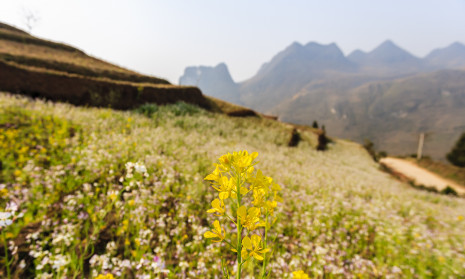
First author email: zhaoaiqin2002@126.com
*Corresponding author email: weixj06@163.com
(Chinese Academy of Agricultural Engineering, Chinese Society of Agricultural Engineering, Postdoctoral Scientific Research Stations of Chinese Academy of Agricultural Engineering, Beijing100125, China)
Summary and Conclusions
China is the world's largest cotton producer, consumer and importer, and Xinjiang is China's largest cotton producing area.
The cotton production in Xinjiang is directly related to the income level of local farmers and also plays an important role in the development of the whole cotton industry.
Xinjiang is situated in an arid region, and all agriculture in Xinjiang depends on irrigation. With the development of urbanization in Xinjiang water resources have become polluted.
Meanwhile, as a result of climate change and the decrease in the availability of the fresh water in Xinjiang, the shortage of water for agriculture becomes increasingly serious. Thus, there is a continuing need for agriculture to reduce its water use rate.
A mulched drip irrigation technique has been proven a great success. In this paper we used a large scale water and nitrogen coupling model, to estimate Xinjiang cotton production potential using mulched drip irrigation under the limited water supply.
Since 2000, the cotton planting area in Xinjiang has shown a fluctuating and increasing trend. Encouraged by the increase of cotton price and government subsidies, the cotton planting area increased significantly after 2017, and the cotton planting area almost reached a maximum.
The total cotton planting area in Xinjiang will be 2×106ha in 2020. In 2020 the estimated maximum amount of water available for agriculture will be 4.95×1010m3and the available water per unit area for cotton will be approximately 3860 m3/ha.
But according to our model, the optimal irrigation rate in southern and northern Xinjiang is 6040 and 5520m3/ha respectively, and the lint yield potential per unit area is 2845 and 2384kg/ha, respectively.
Limited by the amount of water per unit area for cotton in 2020, the lint yield per unit area in southern and northern Xinjiang in 2020 could respectively reach 2721 and 2185 kg/ha, and the total lint yield in Xinjiang could reach 5.1×106tonnes, by using mulched drip-irrigation. This yield will be 21% higher than the target expected by the local government (4.2×106tonnes).
Keywords: water resources; cotton; yield potential; Xinjiang in China; arid area; mulched drip irrigation
Introduction
China is the major producer of cotton(1), and is also the world's largest cotton consumer and importer.
Cotton production in China can greatly affect the world’s cotton market. Xinjiang has become the largest cotton producing area in China depending on its unique light and heat resources with fewer meteorological disasters.
According to China’s statistics, Xinjiang's total cotton output in 2017 was 4.082 million tonnes, accounting for 74.4% of the country's total. Xinjiang has a vast territory and is located in the inland arid area (Fig.1).
Agriculture in Xinjiang is almost totally dependent on irrigation. However, Xinjiang is one of the Chinese provinces with the most serious water shortage. According to Statistic Bureau of Xinjiang Uygur Autonomous Region (2), the per unit area water yield in Xinjiang is only 51 mm, ranking the second to last place in China.
Agriculture is a big user of water: according to 2016 Xinjiang Water Resource Bulletin, agriculture consumes 94.3% of the total.
With climate changes and the acceleration of urbanization, the demand for water by agriculture, people, wildlife and industry is increasing, and water shortage is becoming increasingly serious. Thus, it is urgent to restrict the agricultural consumption of water.
Efficient, water-saving technologies have been widely used in Xinjiang. By the end of 2016, the area of application and promotion of mulched drip irrigation in Xinjiang exceeded 3.33×106ha.
High-efficiency water-saving technology can improve agricultural water use efficiency, to save water consumption without reducing crop yield. According to Goals of Water Conservancy Reform and Development in Xinjiang issued by the Government in 2011, a system of rational allocation and efficient utilization of water resources will be developed, and the proportion of water for agriculture will be reduced by more than 10% by 2020.
Water is the limiting factor to agricultural development in Xinjiang. A reduced supply of water for agriculture will inevitably affect crop yield. In this paper, we investigated the cotton production potential in Xinjiang with limited water resources.
1 Cotton planting and water resources in Xinjiang
1.1 Cotton planting
Xinjiang is located in inland arid and semi-arid areas, within latitudes 73°20'-96°25'E and longitudes 34°15'-49°10'N, about 2 200 km length from the east to the west and 1500 km width from the north to the south. It is surrounded by high mountains.
Southern Xinjiang is the Tarim basin, whereas the northern Xinjiang is the Junggar basin with the Tianshan mountain as the boundary. East Xinjiang is east of Tianshan mountain (Hami and Turpan basin). Xinjiang is a typical temperate continental climate zone, but owing to being far from sea, the climate is dry.
According to recent 20 years data from Water Resource Bulletin, annual precipitation rate is only about 179 mm. The effective rainfall in the growing season of crops is less than 100 mm, so agricultural production is heavily dependent on irrigation water (No irrigation, no production), making it a typical pure irrigation agricultural area(3).
Among the 86 counties and cities in Xinjiang, 63 are dependent on cotton(4). In northern Xinjiang, cotton is mainly planted in Manas and Hutubi in Changji, Shawan and Wusu in Tacheng, Jinghe and Bole in Bozhou (Fig.2).
In southern Xinjiang, the cotton is mainly distributed in Bazhou, Aksu and Kashgar. In Hetian, cotton is mainly interplanted with fruit trees.
1.2 Water resources
High total but low per unit area in Xinjiang Glacier is an important component of Xinjiang water resources and the ratio of glacier melt water to total surface water resources amount is higher than 25%(6).
With global warming, the glacier receding has occurred since 1980s(6) and since 2000 the accelerated glacier shrinkage is observed with the annual glacier volume loss of 1.3%(7). The melting glacier water amount accounts for 12% of mean annual runoff(7).
There are more than 570 rivers in Xinjiang. and the total water resources amount reaches 83.2 billion m3, higher than the national average.
However, the per unit area water yield is one sixth of the national average. From this perspective, Xinjiang has relatively little.
Uneven spatial and temporal distribution From the spatial perspective, the water resources are higher in the west than in the east, and higher in the north than in the south. The amount in the north and west part differs greatly from that of the south and east. Seasonally precipitation occurs mainly from June to August, accounting for 40%-50% (in northern Xinjiang) and 60%-80%(in southern Xinjiang) of the annual total, causing a spring and autumn drought, but summer floods. This distribution of water is inconsistent with regional economic development.
Water environmental deterioration In recent years, the rapid development of agriculture and animal husbandry has led to a high demand for water. This results in the increasing exploitation of surface water and underground water. Additionally surface groundwater pollution caused by the processing of agricultural and associated products, industry, and urbanization is gradually becoming apparent.
1.3 Irrigation water sources in Xinjiang
Agriculture in Xinjiang is totally dependent on irrigation.
Abundant surface and groundwater resources provide sufficient water for irrigation of cotton fields in Xinjiang.
In addition, the melting glacier water in Tianshan Mountain is an important source for irrigation. The traditional irrigation method is flooding irrigation.
Water-saving irrigation such as mulched drip irrigation (an example shown in Fig.3) and subsurface drip irrigation are the main methods for cotton irrigation. In 2016, the area of micro-irrigation accounted for 82.1% of the total area of water-saving irrigation in Xinjiang.
2 Cotton production potential considering limited supply of water
2.1 Cotton planting area changes over the last 18 years and prediction for 2020 in Xinjiang
According to the data of the National Bureau of Statistics of China (Fig.4), the change of cotton planting area in Xinjiang in the recent 18 years includes three stages:
1) In 2000-2005, the cotton sowing area was stable at 0.94×106 ha-1.16×106 ha;
2) In 2006-2016, the cotton planting area fluctuated, but gradually increased. In 2006-2008, it was stable at 1.68×106 ha -1.78×106 ha. In 2009, it was dramatically decreased. After that, it increased again, but again decreased greatly in 2015. In 2008, the international financial crisis caused the cotton planting area in Xinjiang to shrink to 1.41×106 ha in 2009. Since then, driven by the clothing and textile industry, the cotton planting area fluctuated(9). In 2014, the cotton planting area reached 1.95×106 ha, and in 2016, the cotton planting area reached 1.81×106 ha;
3) In recent years, the state has increased cotton price subsidies in Xinjiang, which has played a role in promoting cotton planting in Xinjiang. From 2017 to 2018, the cotton planting area increased significantly to 2.22×106 ha-2.49×106 ha.
The cotton planting area is almost up to the maximum. According to the development plan of Xinjiang with the year of 2015 as the base(10), the cotton planting area will be reduced to 2×106 ha in Xinjiang in 2020.
2.2 Proportion change of agricultural water use and estimation of quantity available for cotton in Xinjiang
According to the data (Fig.5), agricultural water consumption increased slowly before 2010, while the proportion of agricultural water consumption fluctuated around 92% of the total in Xinjiang.
In 2011, both the amount and the proportion of the total water consumption used in agriculture increased significantly, and then decreased slowly after 2012.
Outline of Xinjiang Agricultural and Animal Husbandry Modernization Program (2011-2020) requires that the total annual water supply will be controlled within the limit of 5.5×1010 m3 by 2020 and the proportion of water used for agricultural irrigation in Xinjiang will be reduced to less than 90%.
Thus, the maximum amount of water available for agriculture in 2020 will be 4.95×1010 m3. In 2014, water consumption for cotton in Xinjiang accounted for 15.6% of the agricultural water. According to this ratio, the available water for cotton irrigation in 2020 will be 7.72×109 m3, and that available water per unit area for cotton irrigation will be about 3860 m3/ha.
2.3 Cotton yield potential under mulched drip irrigation in Xinjiang
Cotton yield per unit area is affected by climate, soil, management such as irrigation, variety and other factors.
Among these factors, variety, irrigation and fertilizer are controllable factors. Planting areas greater than 3.3×104 ha the cotton varieties used are mainly Xinlu Zao (60%) and Xinlu Zhong (47%), respectively in the southern and northern Xinjiang(11).
Zhao and Wei have established the large scale water-N coupling model in Xinjiang(12-13). Furthermore, the model was applied to estimate the optimal rate of fertilizer-N and irrigation water for cotton in the southern and northern Xinjiang, respectively (Table 1). The optimal irrigation rate per unit area is 6040 and 5520m3/ha for the southern and northern Xinjiang, respectively(13).
The optimal fertilizer-N application rate is 3250 and 3540 kg/ha for the southern and northern Xinjiang, respectively(13). Under the condition with optimal water and fertilizer-N application rate, the lint yield per hectare in southern and northern Xinjiang is expected to be 2845 and 2384kg/ha, respectively.
Nitrogen fertilizer is widely available so it is not a limiting factor to yield. In 2020, the available rate of irrigation water per hectare of cotton is 3860m3/ha, which is less than the optimal irrigation rate.
Assuming the fertilizer-N application rate is optimal, in 2020, limited by water resources, the potential yield of cotton lint per hectare is estimated to be 2721 and 2185kg/ha for the southern and northern Xinjiang, respectively.
In 2015, the ratio of planting areas in southern and northern Xinjiang is approximately 2:1 based on national statistical data. If this ratio is maintained, the cotton planting area in southern and northern Xinjiang would be 1.33×106 and 0.67×106 ha, respectively based on the predicted total cotton planting area (2×106 ha) in 2020.
Limited by the irrigation water per unit area (3860 m3/ha), the estimated total lint yield by the model would be 1.5×106 and 3.6×106 tonnes, respectively in northern and southern Xinjiang. The total lint yield in Xinjiang under the limits of irrigation water in 2020 would be 5.1×106 tonnes, which is 21% higher than the target yield planned by the local government (4.2×106 tonnes).
2.4 Discussion on negative impacts of long-term plastic film mulching
The cotton lint potential per hectare limited by water resources in 2020 will be 2721 and 2185 kg/ha for the southern and northern Xinjiang, respectively.
The estimation of potential in this paper is based on mulched drip irrigation technique. In current cotton planting, the plastic film is still mostly polythene. The white pollution caused by polythene plastic film has been concerned and discussed(14-15).
It can deteriorate soil environment and may negatively affect the cotton production. Bi et al. shows that there is a critical point of film residue at which the yield reduction rate caused by film residue equals to the yield increasing rate caused by plastic-film mulch(16).
According to Dong et al.’s study, the cotton yield is significantly decreased in Northern Xinjiang after 68 years of film mulching(17). Solutions to solve the film pollution have been discussed(14-15).
The Chinese government has put a lot money in studies on residue recovery machine, degradable film and so on and tried to find suitable machine recovery method and film substitute. Recently, the biodegradable film has been demonstrated in Emin County of Xinjiang(18).
In addition, the government adopted the other measures such as establishing subsidy policy and residual film recycling cooperative to stimulate the initiative of farmers in recycling film residue. The film residue is expected to be greatly lowered.
Acknowledgements
This research work is financially supported by National Natural Science Foundation for Young Scientists of China named “Cotton model studies based on Meta-analysis method”(41601604); The work is also financially supported by China Association for Science and Technology, China.
References
1. Neil C Turner (2017). Sustainable cotton production in Australia and China. World Agriculture,1704 http://www.world-agriculture.net/article/sustainable-cotton-production-in-australia-and-china
2.http://www.xjtj.gov.cn/tjfx/201404/t20140419_429985.html
3.Wang Zhenhua, Yang Peiling, Zheng Xurong, et al (2014). Soil salinity changes of root zone and arable in cotton field with drip irrigation under mulch for different years. Transactions of the Chinese Society o f Agricultural Engineering (Transactions of the CSAE), 30(4) 90-99. DOI: 10.3969/j.issn.1002-6819.2014.04.012
4. Pan Wei, Yang Degang, Yang Li, et al(2011). Spatio-temporal dynamics and optimal development scale of cotton industry in Xinjiang. Chinese Journal of Eco-Agriculture, 19(2) 415-420. DOI: 10.3724/SP.J.1011.2011.00415
5. https://www.sohu.com/a/159118505_611448
6. Li Zhongqin, Li Kaiming, Wang Lin (2010). Study on recent glacier changes and their impact on water resources in Xinjiang, north western China. Quaternary Sciences, 30(1): 96-106. DOI:10.3969/j.issn.1001-7410.2010.01.09
7. Zhang Hui, Li Zhongqin, Mu Jianxin, He Haidi (2017). Impact of the glacier change on water resources in the Kuytun River Basin, Tianshan Mountains during recent 50 years. Scientia Geographica Sinica, 37(11),1771-1777. DOI:10.13249/j.cnki.sgs.2017.11.020
8. Wang Jun, Li Jiusheng, Guan Hongjie (2016). Modeling the response of cotton yield and water productivity to irrigation amount under mulched drip irrigation for cotton growing in the North Xinjiang Uygur Autonomous Region. Transactions of the Chinese Society of Agricultural Engineering (Transactions of the CSAE), 32(3): 62-68. (in Chinese with English abstract) doi:10.11975/j.issn.1002-6819.2016.03.000
9. http://www.chyxx.com/industry/201901/703901.html
10. http://www.xjeic.gov.cn/2017/01/10/ghzt/36090.html
11. Wang Junduo, Li Xueyuan, Liang Yajun, et al (2018) . Report of cotton seed industry in 2017 in Xinjiang. Cotton Sciences, 40(5)5-11. DOI: 10.3969/j.issn.2095-3143.2018.05.002
12. Zhao Aiqin, Wei Xiuju (2016). Water-fertilizer coupling model-based cotton production potential under drip irrigation with plastic film mulching in Xinjiang of China. 2016 ASA-CSA-SSSA Annual Meeting, Nov. 6-9, Phoenix, AZ. < https://dl.sciencesocieties.org/publications/meetings/2016am/16231 >
13. Zhao Aiqin (2019). Mulched drip irrigation cotton yield potential estimation based on large-scale water-nitrogen coupling model in Xinjiang, China with limits of water sources. Transactions of the Chinese Society of Agricultural Engineering (Transactions of the CSAE), 35(5):111-118. DOI:10.11975/j.issn.1002-6819.2019.05.013
14. Yan C, He W, Turner N C, Liu E, Liu Q, Liu S (2014). Plastic-film mulch in Chinese Agriculture: Importance and problems. World Agriculture 4, 32-36.
15. Yan C, Mei X, He W, Zheng S (2006). Present situation of residue pollution of mulching plastic film and controlling measures. Transactions of the Chinese Society of Agricultural Engineering (Transactions of the CSAE), 22(11),269-272.
16. Bi Jiye,Wang Xiufen,Zhu Daolin (2008).Effect of plastic-film mulch on crop yield.Transactions of the Chinese Society of Agricultural Engineering (Transactions of the CSAE), 24(11):172-175
17. Dong Hegan, Liu Tong, Li Yongguan, Liu Huafeng, Wang Dong (2013).Effects of plastic film residue on cotton yield and soil physical and chemical properties in Xinjiang. Transactions of the Chinese Society of Agricultural Engineering (Transactions of the CSAE), 29(8):91-99.
18. http://news.ifeng.com/c/7faEP8Hh8Gl
Download pdfFigures
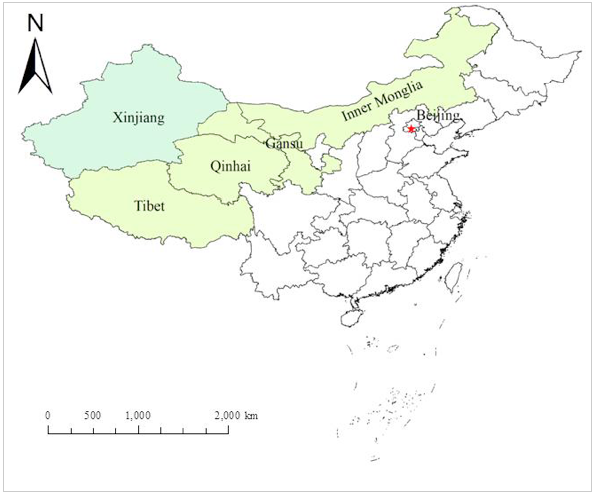
Fig.1 Location of Xinjiang in China
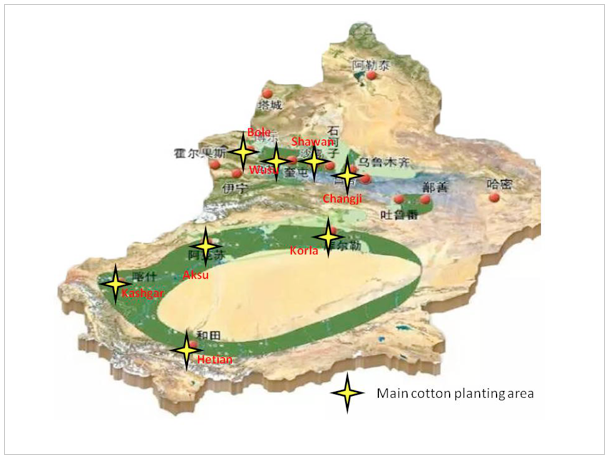
Fig.2 Schematic map of cotton planting area in Xinjiang(5)

Fig.3 Typical cotton planting pattern in Xinjiang under mulched drip irrigation(8)
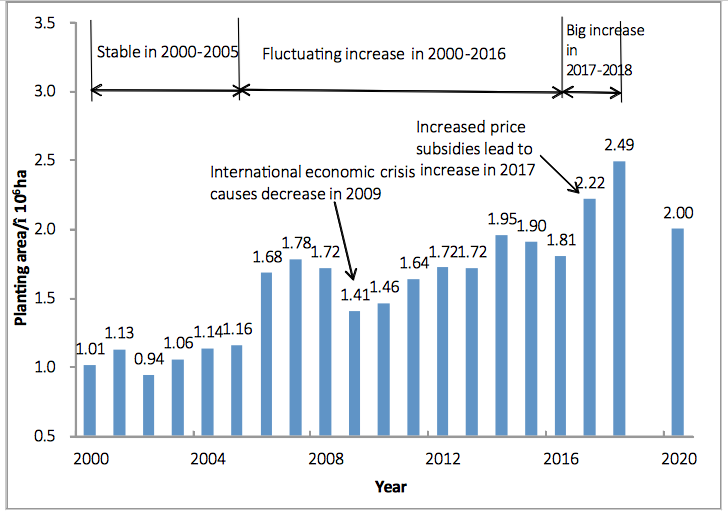
Fig.4 Cotton planting area change in Xinjiang since 2000
Note: Data from National Bureau of Statistics of China. Data for 2020 is based on the development plan of Xinjiang(10).
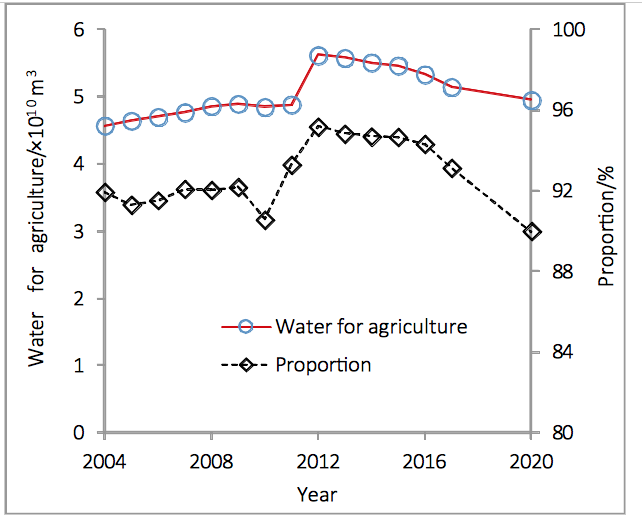
Fig.5 Changes of total water consumption for agriculture and its proportion for cotton production in Xinjiang
Note: Data from National Bureau of Statistics of China. Data for the year of 2020 is calculated based on Outline of Xinjiang Agricultural and Animal Husbandry Modernization Program (2011-2020).
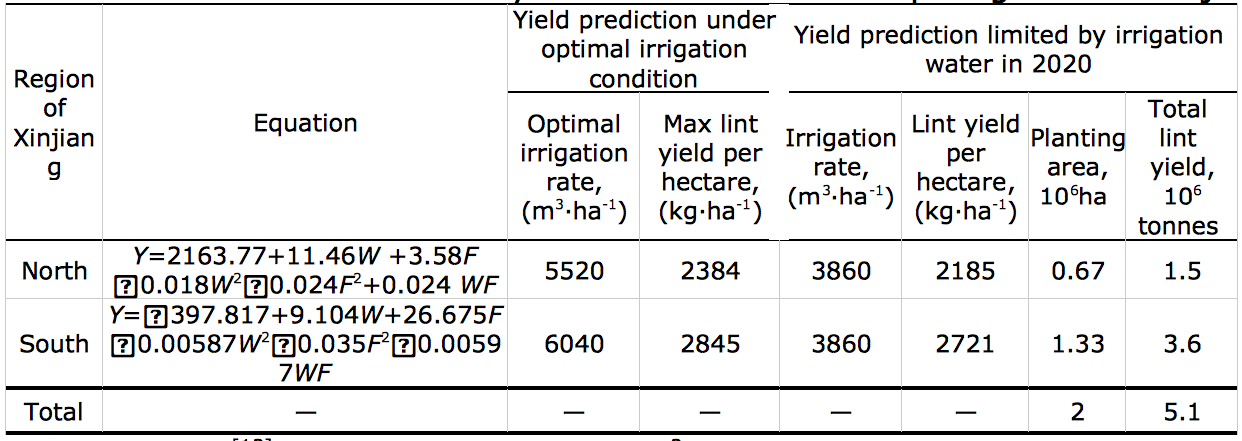
Table 1 Estimation of cotton lint yield under mulched drip irrigation in Xinjiang
Note: In models(13), W is irrigation rate, m3/ha; F is fertilizer-N application rate, kg/ha; Y is cotton seed yield, kg·ha-1. The optimal fertilizer-N rate is 3540 and 3250kg/ha respectively for the northern and southern region(13). Cotton lint yield equal to 40% or 42% of cotton seed yield for northern or southern Xinjiang, respectively(13).

